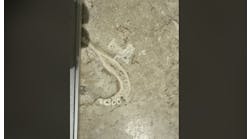Congratulations! You can finally call yourself a registered dental hygienist. Now you’re eager to find your first job as a licensed health-care provider. After scouring dental job boards, you send numerous applications and wait to hear back. When you do, some practices ask you to come in for a traditional interview, while others want to schedule a working interview.
I consider working interviews an excellent opportunity to immerse yourself in the office culture and practices to see if you’re a good fit. Here are six warning signs to look for during your time with the team. These are not necessarily reasons to decline a job offer, but rather areas that need to be addressed before you do accept a position.
Inadequate time is scheduled for appointments
Determine how much time you need to practice quality patient care and look for an office that will accommodate that. For me, optimal appointment length for adult prophylaxis and periodontal maintenance is 60 minutes; two quads of scaling and root planing is 60 to 90 minutes depending on the amount of calculus and type of anesthesia; a new-patient appointment is 90 minutes; and a child prophylaxis is 40 to 45 minutes, age 12 and under with no braces and no sealants needed.
You may have to compromise on some of these. For example, maybe you’re able to get all the above except children are given 30-minute appointments. That could be acceptable. However, if all appointments are shorter than you need them to be, the quality of care you provide will likely suffer and your stress level is bound to increase, which can lead to job dissatisfaction and burnout.
There are no periodontal charts
Lack of or infrequent or incomplete periodontal charting is a concern. Try to find out the reason. Is the computer too far away from the operator? Is everyone too busy to help record the measurements? Did the practice recently switch from paper charts to digital and they have not started using all functions of the software? Or do they not place a high level of importance on periodontal health?
Ask questions and find out if you’ll be able to practice at this standard of care. According to the American Academy of Periodontology, periodontal charting is required at least every 12 months.1 Ideally, it should be updated at every visit.
Periodontal disease is not treated
Failure to diagnose and treat periodontal disease does not serve patients well and is the fifth most common cause for a malpractice suit.2 If all your patients that day are scheduled for prophylaxis, check if the following few days look the same.
Pay careful attention to each patient’s periodontal health. Do they have signs of periodontal disease that warrant therapy versus prevention? If so, did the condition develop since their last hygiene appointment (perhaps they missed a visit or two) or was there prior evidence of this?
Regardless, make a recommendation for treatment based on your knowledge and see if the doctor supports you. If you differ in how you diagnose gingival and periodontal conditions, that may be a serious source of contention. Be sure to discuss periodontal protocols before you accept a position.
Instruments and equipment are in poor condition
Note if the equipment is fairly modern and in good working condition. Is tape holding the x-ray tube head together? Are the patient chairs so old that the headrest is not adjustable and there’s a lever to raise the chair?
Inspect the instruments. Are they dull? Are there multiple instruments with tips broken off, probes with difficult-to-see markings, ultrasonic tips and air/water syringes that leak? Ask how often instruments are purchased and if they’re willing to supply one or two specific instruments that you prefer to use. Are there enough ultrasonic scaler tips or plans to purchase more? What about replacing or repairing old equipment? Keep in mind the dentists may not be aware of these issues since they don’t use hygiene tools.
Space is not ergonomically designed
When you’re working at a prospective employer’s office, notice the operatory design. Is there enough space to sit in all clock positions, including 12 o’clock? Is the operatory small and crammed or spacious to allow free movement? Is the equipment ergonomic? Each part of the operator chair and patient chair should be fully adjustable.
Is everything positioned conveniently so you don’t have to reach or stand to get it? The computer should be located at an arm’s length so you can document periodontal findings. In the event it’s too far, ask if there’s voice-recording software that assists with periodontal charting. The ultrasonic scaler should be on the side of the operator and easily accessible. Note if there is short or rigid tubing that needs to be replaced. Express your concern and request that modifications be made.
There are unacceptable infection control practices
Good infection control is extremely important. Pay attention to whether the doctors and clinical team follow CDC and OSHA regulations. Are they using store-bought wipes instead of medical grade disinfectant wipes? Are they scrubbing instruments by hand rather than using an ultrasonic cleaner? Are x-ray bite blocks being wiped and used on the next patient without being sterilized? Are open instruments sitting in drawers? What aerosol mitigation strategies are in place? How often do they test their waterlines and how are these disinfected? Find out before you gain employment.
Hopefully you’re on your way to your perfect dental home. A working interview is a great way to view the schedule, use the equipment, interact with the patients and staff, and decide whether you can envision yourself working there.
Do not miss the opportunity to find your perfect dental home by accepting a position without a working interview, no matter how good the offer is. Keep these considerations in mind when you’re going through the hiring process and you’re sure to find a practice where you’ll love working every day.
References
1. Comprehensive periodontal examination. American Academy of Periodontology. Accessed March 30, 2024. https://www.perio.org/for-patients/gum-disease-information/comprehensive-periodontal-evaluation/
2. 7 most common dental lawsuits (and how to avoid them). Advantage Insurance Solutions. August 6, 2020. Accessed March 30, 2024. https://www.teamais.net/blog/7-common-lawsuits-for-dental-malpractice-and-how-to-avoid-them/
Anastassia Stoenelova, BA, RDH, has been in dentistry for 10 years. She is from Bulgaria and has been living and working in the United Stated for 20 years. She currently practices clinically in Atlanta, Georgia. As a former ESL instructor, she is passionate about oral health education and making a difference in her patients’ lives every day. She also works with Second Wind Dreams, a nonprofit organization that educates health-care professionals about dementia, and she is a personal recruiter for CUSP dental app. She can be reached at [email protected].








